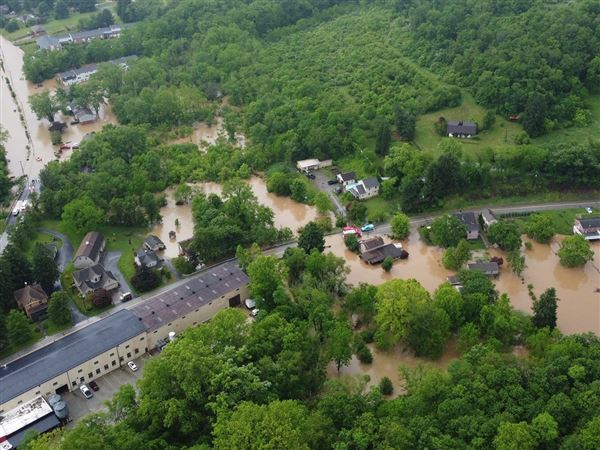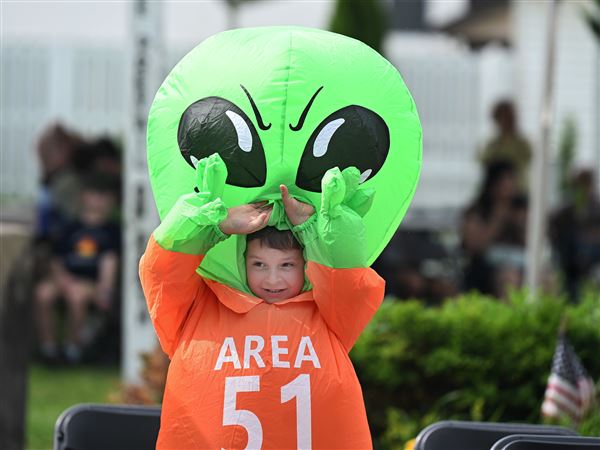
The flowers on 'Lady in Red' bigleaf hydrangea start out blue but turn red in the fall.
Click photo for larger image.
One of the most frequently asked gardening questions on the Phipps' plant question hot line is: "Why don't my hydrangeas flower?"
There are several species (kinds) of hydrangea. The classic, old-fashioned hydrangea or bigleaf hydrangea (Hydrangea macrophylla) can be divided into two groups -- lacecaps and mopheads. Lacecaps produce flat flower clusters having an outer ring of showy, sterile flowers that surround a center of smaller, infertile flowers. The mopheads are spectacular in flower with large billowy clusters of white, pink or blue flowers.
Unfortunately, bigleaf hydrangeas do not consistently flower in northern climates. There may be several reasons: The plant may be sited in too much shade, the area may be too wet or too dry or the plant may be pruned incorrectly or at the wrong time. However, the most likely reason is that the flower buds of many varieties are not cold hardy in Western Pennsylvania.
While the plant is thriving because the root system is hardy, it never flowers because buds, which are set on the previous season's wood, are damaged by extremely cold temperatures or late spring frosts. This is often the case with potted hydrangeas from the florist but can also be true with ones from local nurseries.
The exciting news is that re-blooming bigleaf hydrangeas that flower on both new and old wood have been bred and are available at nurseries. Last year, 'Endless Summer' was extremely popular because, as the name suggests, it produces large mop-head flowers throughout the summer.
The flowers can be either pink or blue depending on soil pH. To ensure pink flowers, incorporate a handful of lime to the soil when planting to create an alkaline soil. Add aluminum sulfate if you prefer blue flowers.
Another breakthrough hydrangea will be available at nurseries this summer. Unlike most bigleaf hydrangeas, 'Lady in Red' puts on a show throughout the season. Beginning in spring, the newly emerging leaves have prominent red veins and crimson stems. The pink lace-cap flowers appear in the summer and gradually mature to a rich burgundy rose. In the fall, the foliage turns deep mahogany purple. 'Lady in Red' is hardy to zone 6, so it may only be appropriate for city gardens or protected areas.

The leaves on 'Lady in Red' have red veins and edges.
Click photo for larger image.

'Endless Summer' is a popular hydrangea because it produces blooms through the summer.
Click photo for larger image.
Another popular species of hydrangea is Hydrangea paniculata. Unlike bigleaf hydrangeas, panicled hydrangeas flower on new wood, so they bloom consistently in late summer. The showy flowers are pyramidal in shape and often change from white to a dusty pink as they age. One of the newer introductions, 'Limelight,' has bright lime-green flower heads that make a spectacular show throughout the summer.
The chartreuse foliage of 'Little Honey' oakleaf hydrangea (Hydrangea quercifolia) makes it another popular selection. 'Little Honey' is more diminutive than the species (parent), reaching only 3 to 4 feet high. Like the species, it produces pyramidal clusters of creamy white flowers that gradually change to a light rose. But it is the lime-green foliage that makes this plant distinctive.
Hydrangeas also include climbers, which attach not only to fences and walls but also to trees to create a three-dimensional effect. The newest introduction of climbing hydrangea, Hydrangea anomala spp. petiolaris 'Mirranda,' has variegated foliage. The new leaves are edged with an irregular margin of yellow and in late summer, the plant produces flat-topped white flowers that are fragrant.
To learn more about the many varieties of hydrangeas and their culture, stop by Phipps Garden Center, 1059 Shady Ave., Shadyside, at 2 p.m. tomorrow for a free program. Bill Hendricks, president of Klyn Nurseries in Ohio, will present a special lecture, "The Hydrangea Craze: From Lacecaps to Mops." To register, call 412-441-4442.
There are also two recently published books: "Hydrangeas for American Gardens" by Michael Dirr (Timber Press, $29.95) and "The Encyclopedia of Hydrangeas" by the C.J. and D.M. van Gelderens (Timber Press, $49.95).
First Published: February 26, 2005, 5:00 a.m.














